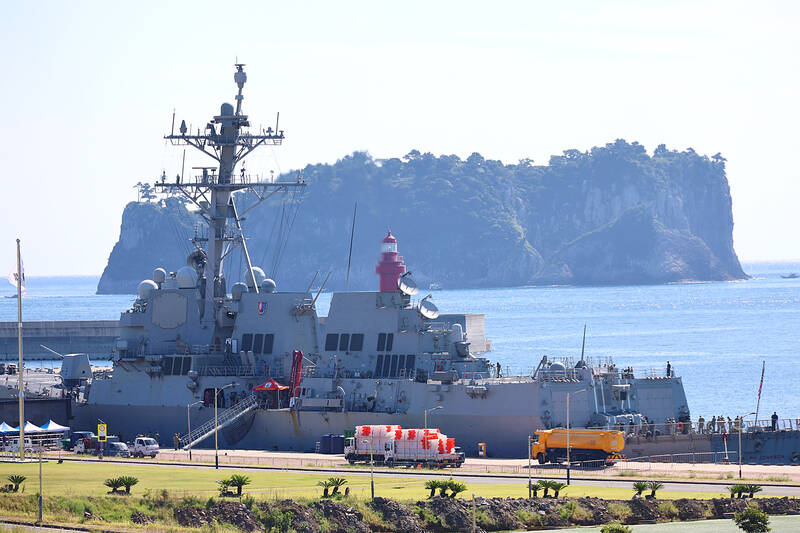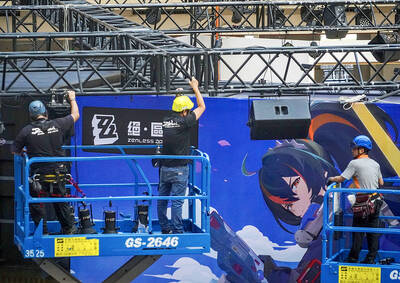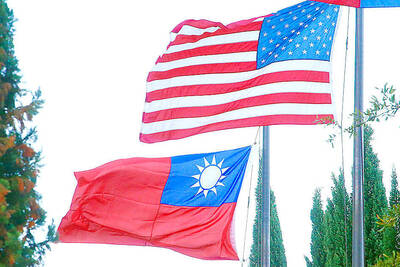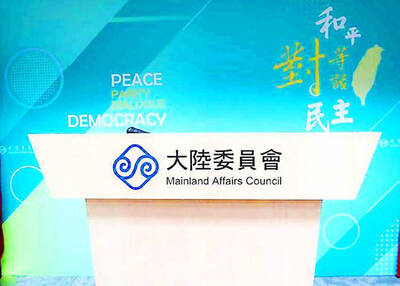Two US military vessels transited the Taiwan Strait from Sunday through early yesterday, the Ministry of National Defense said in a statement, the first such mission since US President Donald Trump took office last month.
The two vessels sailed south through the Strait, the ministry said, adding that it closely monitored nearby airspace and waters at the time and observed nothing unusual.
The ministry did not name the two vessels, but the US Navy identified them as the Arleigh Burke-class guided-missile destroyer USS Ralph Johnson and the Pathfinder-class survey ship USNS Bowditch.

Photo: EPA-EFE
The ships carried out a north-to-south transit from Monday to yesterday, a US military spokesperson said.
“The transit occurred through a corridor in the Taiwan Strait that is beyond any coastal state’s territorial seas,” said US Navy Commander Matthew Comer, a spokesperson at the US military’s Indo-Pacific Command.
“Within this corridor all nations enjoy high-seas freedom of navigation, overflight and other internationally lawful uses of the sea related to these freedoms,” Comer said.
The US 7th Fleet did not publicize the passage in a news release, as was standard during the previous administration of former US president Joe Biden.
The confirmations made by the US and Taiwanese militaries came after China made a statement regarding the transit earlier yesterday.
The Chinese state-run Global Times quoted Chinese People’s Liberation Army (PLA) Eastern Theater Command spokesman Li Xi (李熹) as saying that Chinese forces have “deployed naval and air forces to monitor the entire passage of the US vessels, effectively responding to and managing the situation.”
“The actions of the US sent the wrong signals and increased security risks. The Eastern Theater Command remains on high alert, resolutely safeguarding national sovereignty and security, as well as regional peace and stability,” Li said.
China’s Taiwan Affairs Office spokeswoman Zhu Fenglian (朱鳳蓮) in Beijing said that Taiwan was a “core interest” for the country and that the US should act with caution.
“We are resolutely opposed to this and will never allow any outside interference, and have the firm will, full confidence and capability to uphold the country’s sovereignty and territorial integrity,” she said.
“I really do not need to explain further who is the so-called troublemaker around the Taiwan Strait. All other countries in the neighborhood have a deep appreciation of this,” ministry spokesman Sun Li-fang (孫立方) told reporters in Taipei.
The US Navy, sometimes joined by allies, makes regular transits through the Taiwan Strait in what it calls exercising freedom of navigation rights.
The last time a US warship transited the Strait was on Oct. 20 last year.
It was an Arleigh Burke-class guided-missile destroyer USS Higgins, along with a Royal Canadian Navy Halifax-class frigate HMCS Vancouver.
Chinese state television yesterday said that since Lunar New Year’s Eve on Jan. 28, the PLA’s Eastern Theater Command had repeatedly dispatched sea and air forces to carry out “combat readiness” patrols and training missions around Taiwan.
The operations aim to “guard the joy and peace of the people on both sides of the Taiwan Strait,” the report said.

Taiwan is projected to lose a working-age population of about 6.67 million people in two waves of retirement in the coming years, as the nation confronts accelerating demographic decline and a shortage of younger workers to take their place, the Ministry of the Interior said. Taiwan experienced its largest baby boom between 1958 and 1966, when the population grew by 3.78 million, followed by a second surge of 2.89 million between 1976 and 1982, ministry data showed. In 2023, the first of those baby boom generations — those born in the late 1950s and early 1960s — began to enter retirement, triggering

One of two tropical depressions that formed off Taiwan yesterday morning could turn into a moderate typhoon by the weekend, the Central Weather Administration (CWA) said yesterday. Tropical Depression No. 21 formed at 8am about 1,850km off the southeast coast, CWA forecaster Lee Meng-hsuan (李孟軒) said. The weather system is expected to move northwest as it builds momentum, possibly intensifying this weekend into a typhoon, which would be called Mitag, Lee said. The radius of the storm is expected to reach almost 200km, she said. It is forecast to approach the southeast of Taiwan on Monday next week and pass through the Bashi Channel

NO CHANGE: The TRA makes clear that the US does not consider the status of Taiwan to have been determined by WWII-era documents, a former AIT deputy director said The American Institute in Taiwan’s (AIT) comments that World War-II era documents do not determine Taiwan’s political status accurately conveyed the US’ stance, the US Department of State said. An AIT spokesperson on Saturday said that a Chinese official mischaracterized World War II-era documents as stating that Taiwan was ceded to the China. The remarks from the US’ de facto embassy in Taiwan drew criticism from the Ma Ying-jeou Foundation, whose director said the comments put Taiwan in danger. The Chinese-language United Daily News yesterday reported that a US State Department spokesperson confirmed the AIT’s position. They added that the US would continue to

The number of Chinese spouses applying for dependent residency as well as long-term residency in Taiwan has decreased, the Mainland Affairs Council said yesterday, adding that the reduction of Chinese spouses staying or living in Taiwan is only one facet reflecting the general decrease in the number of people willing to get married in Taiwan. The number of Chinese spouses applying for dependent residency last year was 7,123, down by 2,931, or 29.15 percent, from the previous year. The same census showed that the number of Chinese spouses applying for long-term residency and receiving approval last year stood at 2,973, down 1,520,